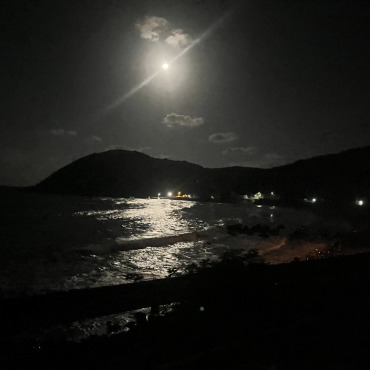
An Ultra-Distance Journey by a Gravel Enthusiast
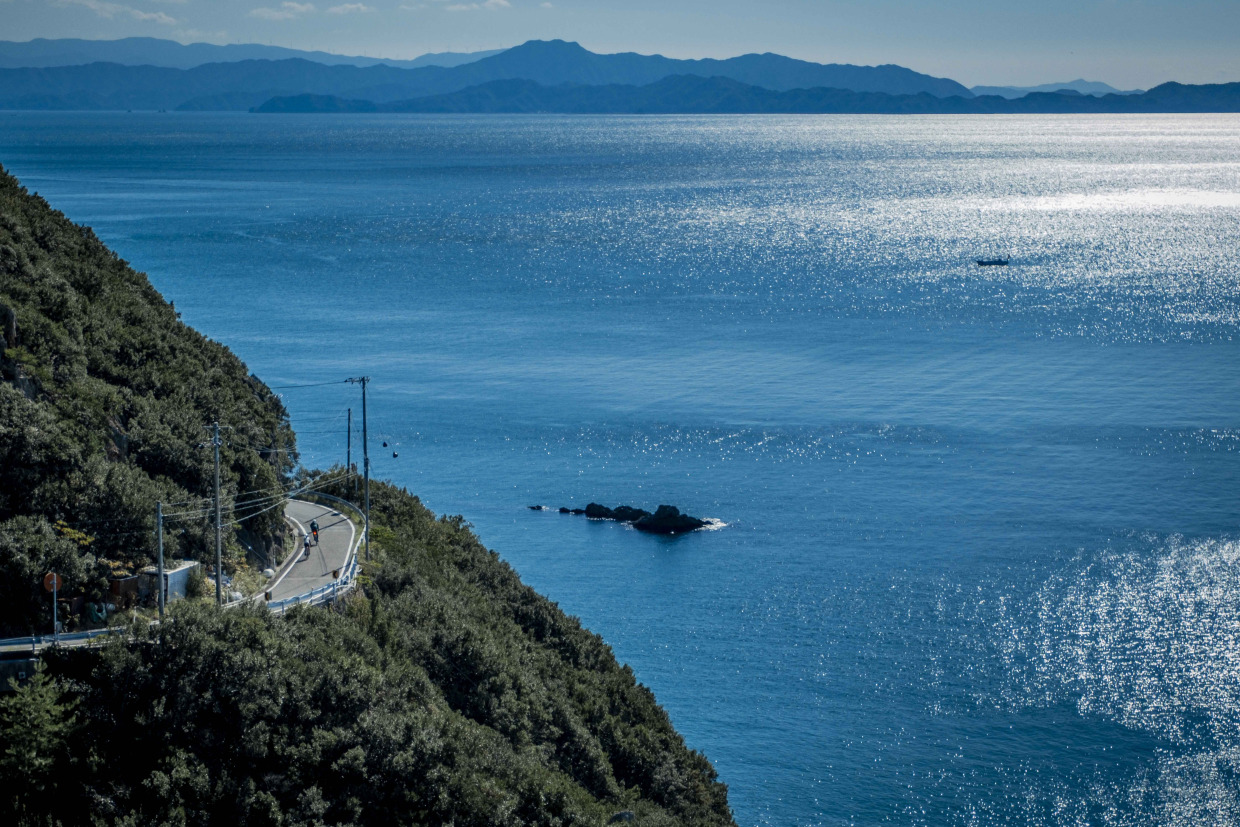
*Check out Race Report #01 & #02 here.
https://globalride.jp/trip-travel/ehimemonitortour24_01_en/
https://globalride.jp/trip-travel/ehimemonitortour24_02_en/
1. Touring the Fishing Villages and Capes of Southern Ehime (Uwajima City)
2. Our Everyday Lives Become Someone’s Entertainment (Uwajima City – Matsuyama City)
Already, the Ehime tour has reached its fifth morning. As we enjoy a homemade Japanese breakfast at Kokuriko, the cozy rural dormitory that has hosted us for the past two days in Uchiko, our conversation with the owners, spoken in the gentle lilt of the Ehime dialect, is just beginning to reach full bloom… Yet, it’s already time to say goodbye. Parting feels too soon. Since its opening in 1996, this guesthouse has been at the forefront of green tourism, deeply rooted in the local community. Our stay in Uchiko and Ōzu has been filled with their warm hospitality, leaving us feeling truly at home.
Cooper, our fellow traveler, is visibly teary-eyed at the farewell, but we gather for a final group photo before heading off.
Reflecting on the past four days, we’ve already cycled the Shimanami Kaidō, traversed the deep valleys of the Ishizuchi mountain range, and immersed ourselves in the people and culture of Uchiko and Ōzu. We’ve already covered two-thirds of Ehime. What more could we possibly seek? The thought crosses my mind, feeling utterly fulfilled by all that Ehime has to offer.
And yet, two more days remain on our journey. Looking at the route ahead, new excitement stirs within me. Clearly, the organizers of this tour have crafted an itinerary with extraordinary intent.
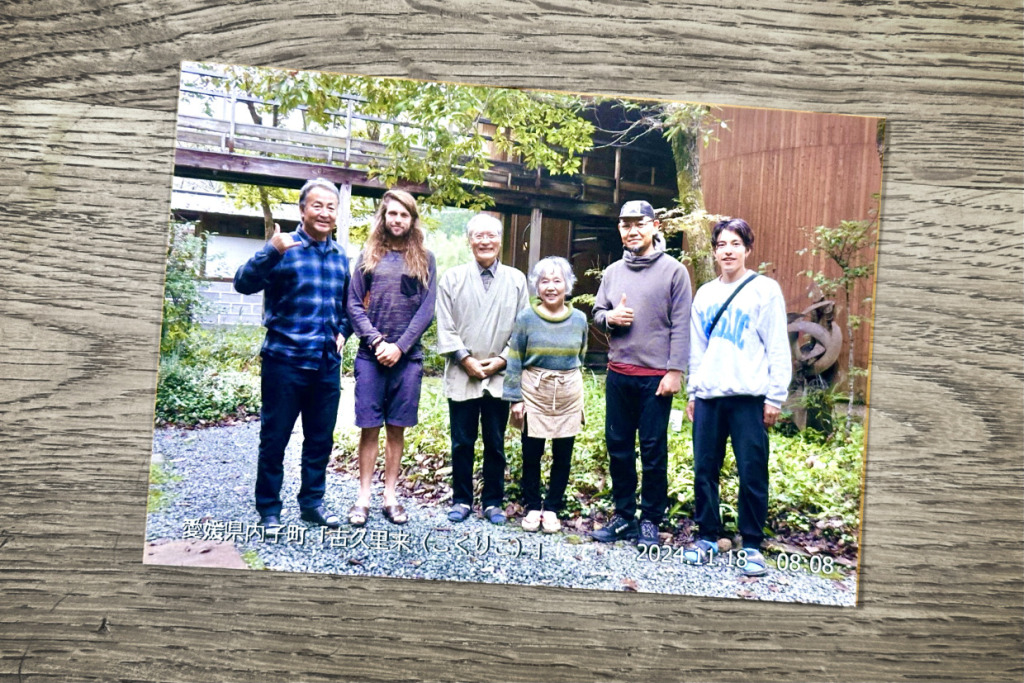
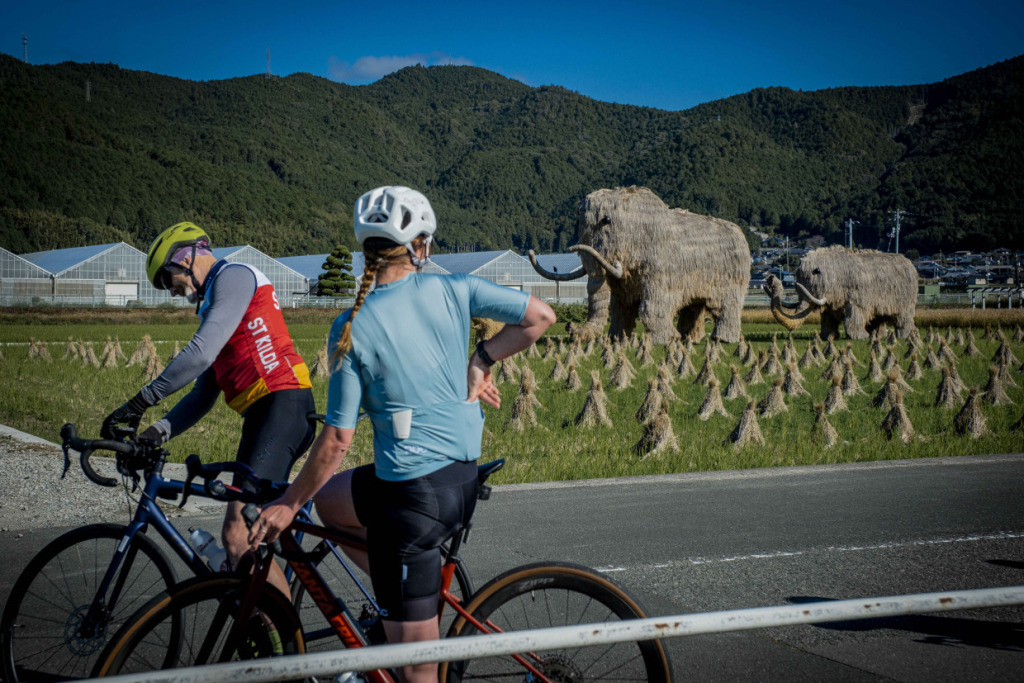
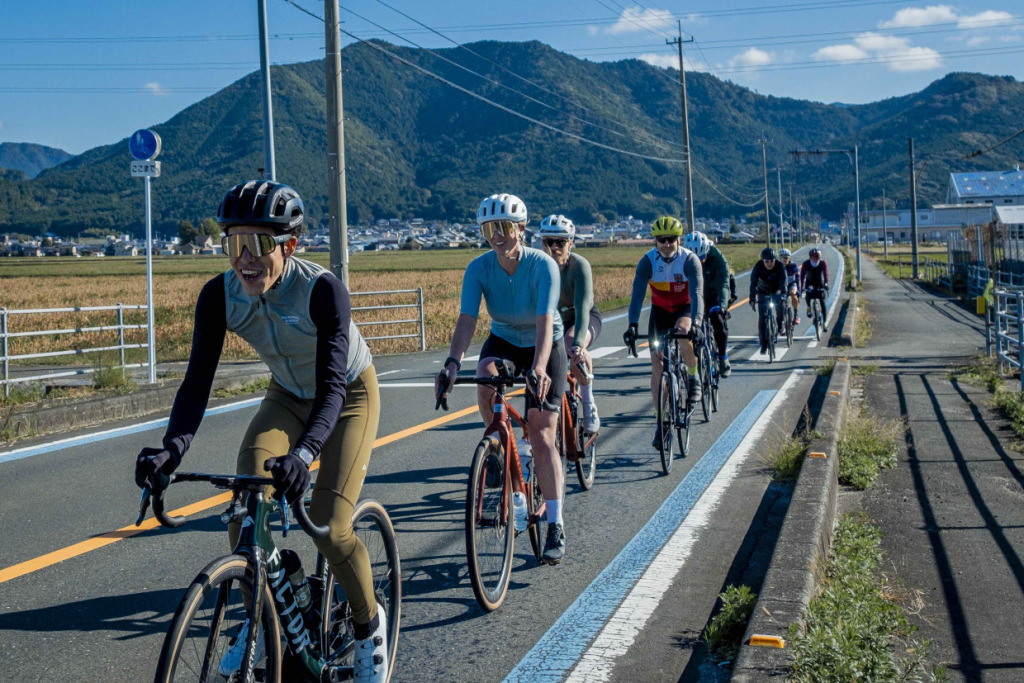
To uncover the source of this anticipation, today we set our sights on Uwajima, the central city of the Nanyo region in southwestern Ehime.
Our route takes us from Uchiko through the Uwa Basin, then along the stunningly scenic rias coastline before arriving in Uwajima. Personally, this segment of the tour is the one I’ve been looking forward to the most. For cyclists based in the Kanto region, the opportunity to ride here is rare. I’ve long heard whispers among fellow cyclists that this route is a must-ride, something to truly covet. I’ve imagined it countless times—closing my eyes, I picture the view across the Bungo Channel toward the mountains of Kyushu, the winding coastal roads rising and falling, weaving through capes adorned with brilliant orange mikan groves… Ah, can one even call themselves a cyclist without experiencing this?
I catch myself getting overly excited, but our international companions seem just as tireless as ever. Even this morning, their eyes gleam with anticipation.
And best of all, today brings the long-awaited clear skies—a vast expanse of perfect blue. With such high expectations, my pedals feel effortlessly light as we set off.
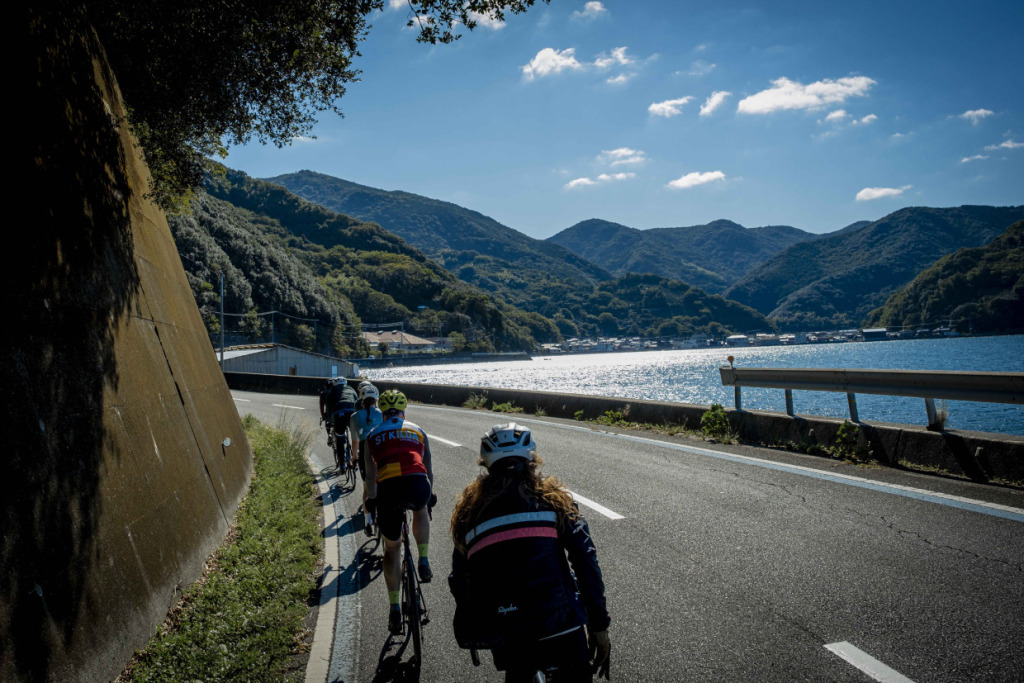
Heading toward the much-anticipated rias coastline, we first take an easy spin through the Uwa Basin’s rural landscape, departing from inland Uchiko. Here, giant mammoth parents and their calf seem to roam the fields—or so it appears. The towering waraguro haystacks, a classic autumn and winter sight in Shikoku’s countryside, stand alongside massive straw sculptures of a mammoth family, creating a picture-perfect scene beneath the vivid late-autumn sky.
After a brief but unexpected encounter with these prehistoric figures, our cycling train surges ahead, slicing through the crisp morning air. We climb over a few gentle hills, then choose a valley leading from the inland plains toward the sea, marking our first ascent of the day. The climb, offering just the right amount of punch, is tackled with ease. Then comes the descent—gravity takes over, and we glide effortlessly downward.
As the wind rushes past, the view ahead accelerates, and suddenly, an expanse of brilliant blue bursts into sight. The sea, impossibly blue, shimmers under the sunlight as if to dazzle us on purpose. In the distance, the silhouette of a vast island—Kyushu, no doubt—looms across the water.
At last, we have arrived at the long-awaited Bungo Channel. The long-dreamed-of ride along the capes of Nanyo is about to begin.
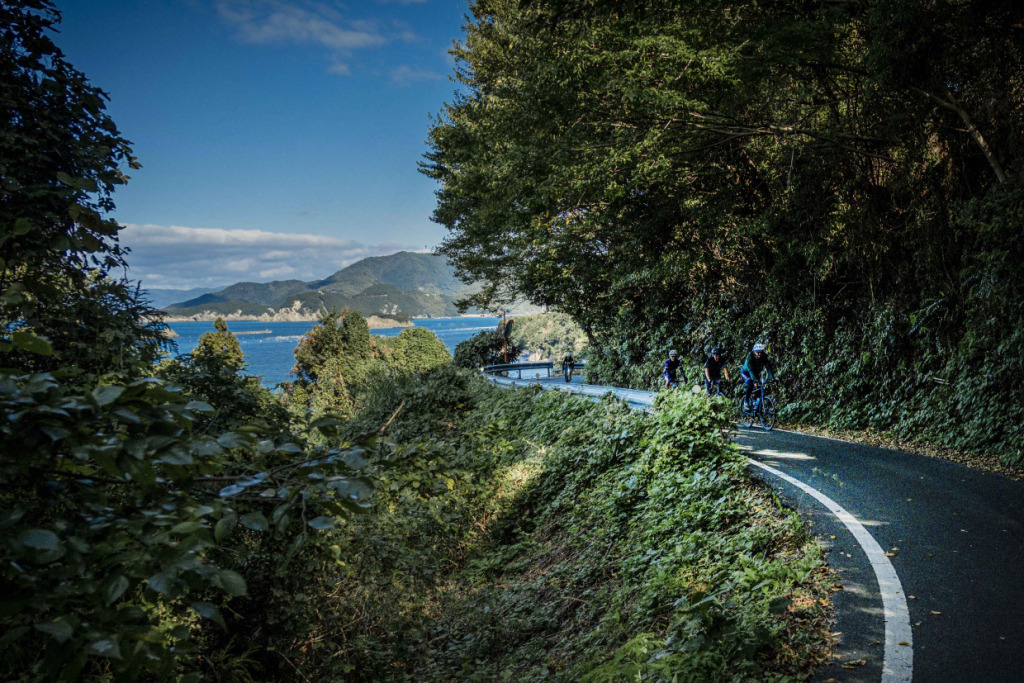
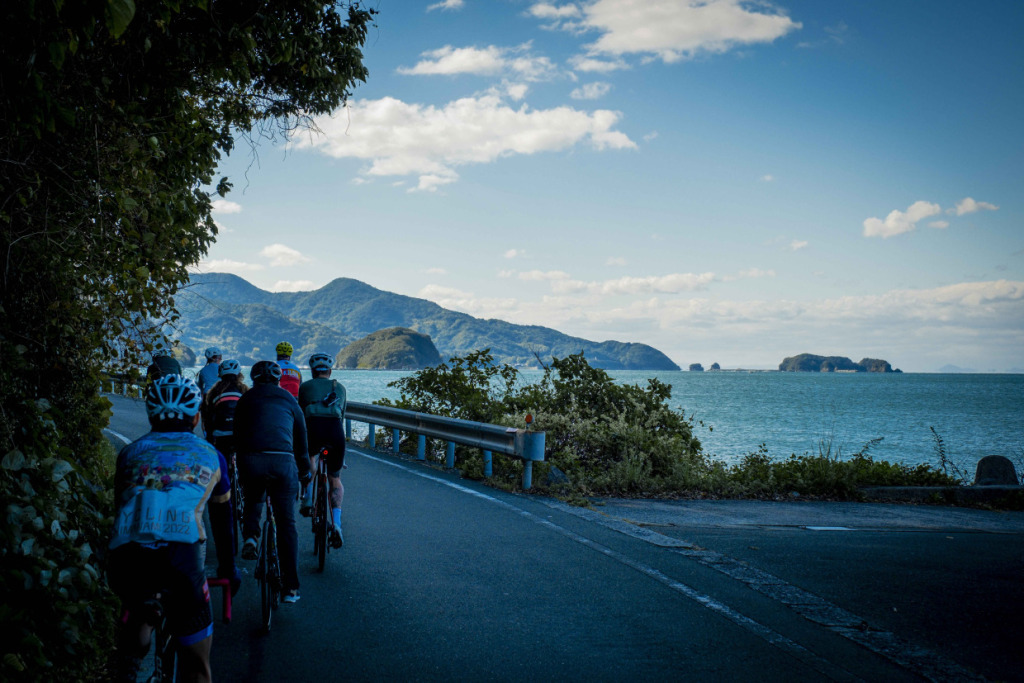
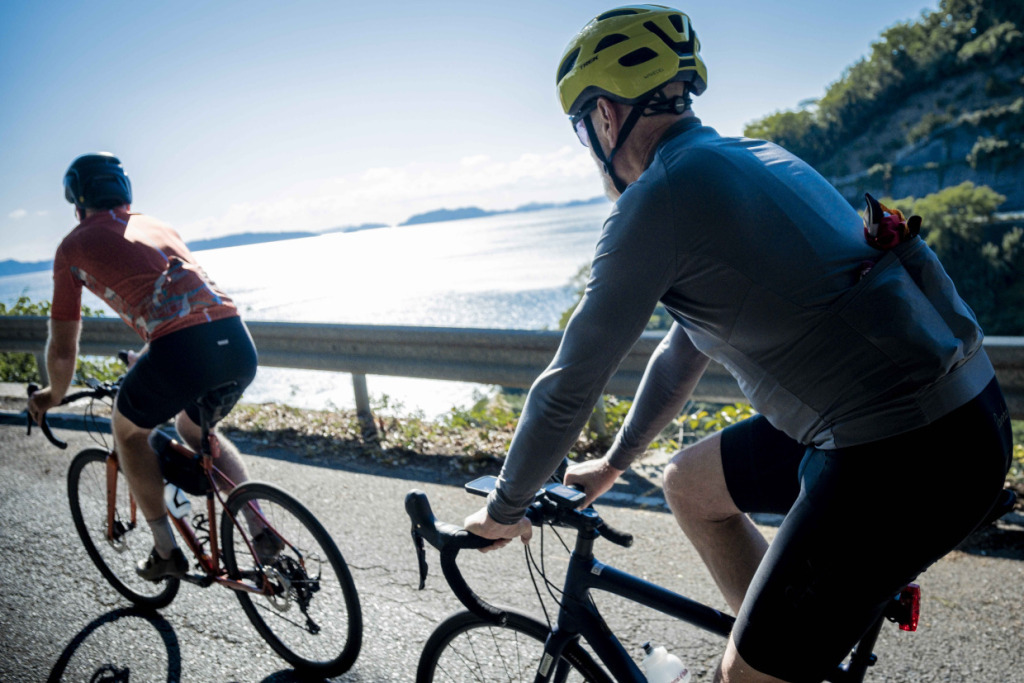
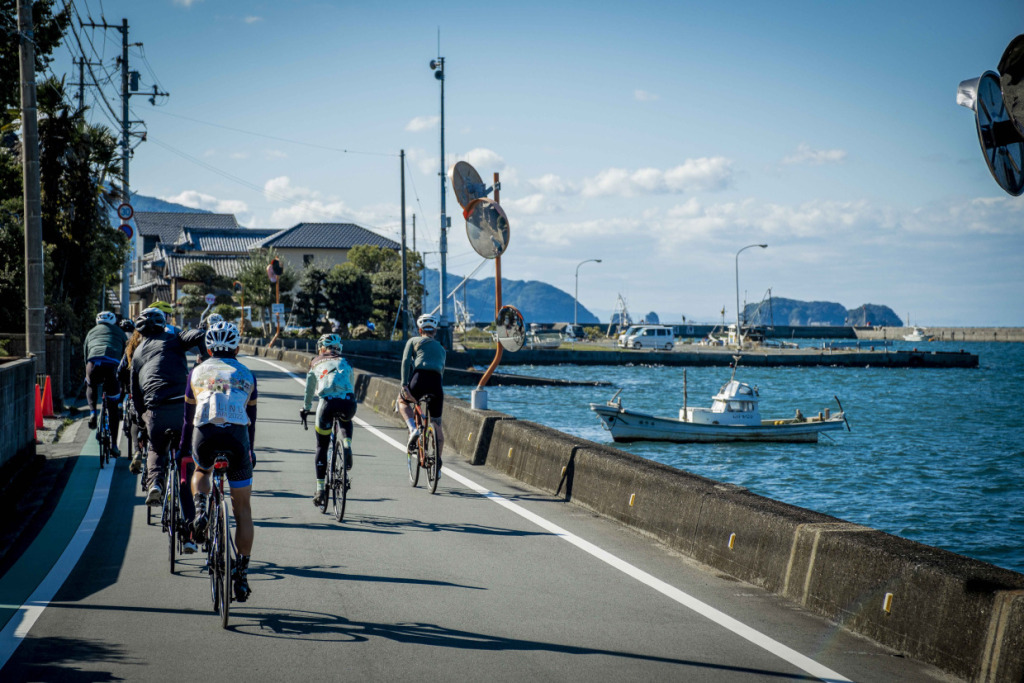
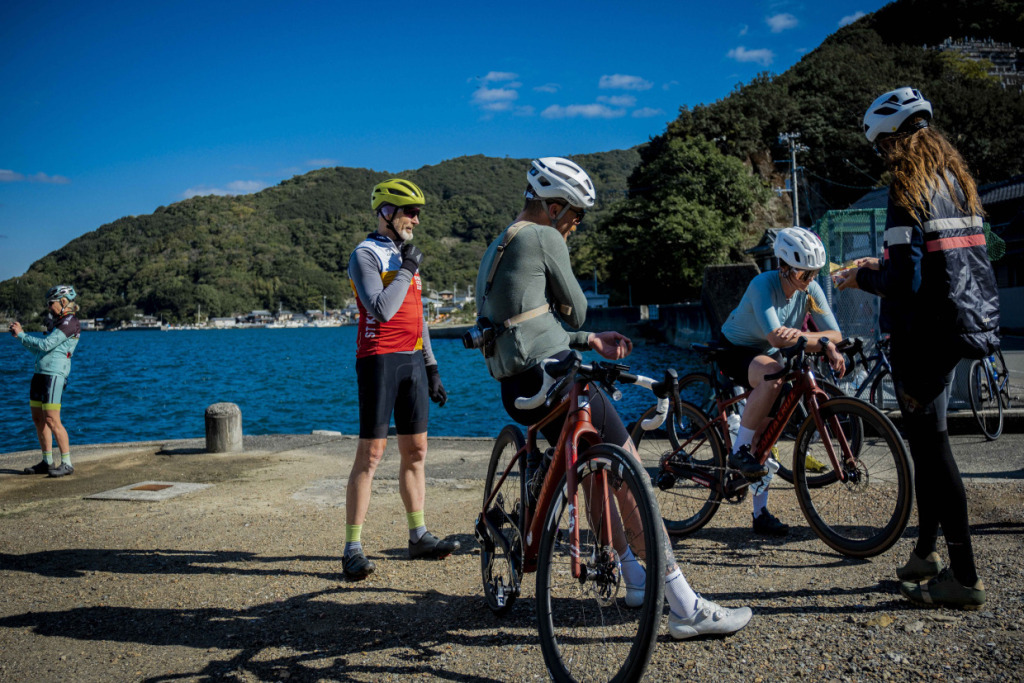
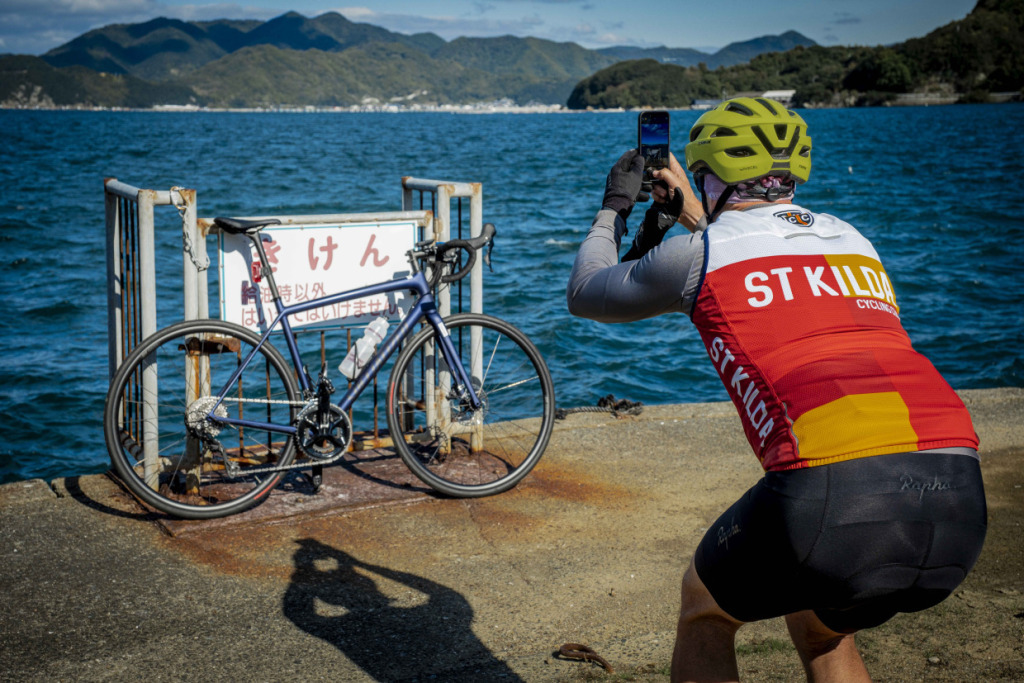
The deeply indented rias coastline unfolds a new scene with each inlet we pass. Scattered along the shore are small fishing villages, where nostalgic enka melodies drift from the port’s loudspeakers, evoking a rustic charm. Though it’s still early in the morning, fishermen—who began their work long before sunrise—can be seen tidying up their gear, cigarettes in hand.
Leaving the villages behind, the inevitable climbs begin. The rolling ascents and descents around the capes offer just the right amount of challenge for the legs. On the steep, sunlit slopes of the capes, vibrant mandarin orchards thrive. The bright orange fruits dotting the lush green hillsides create a striking contrast, a feast for the eyes. A bit of effort is rewarded at the top, where the panoramic view opens up, revealing the breathtaking expanse of the Bungo Channel below.
We ride past one nameless cape after another, and though we are looking at the same sea each time, it somehow appears different with every turn. It must be the magic of this ever-changing rias landscape.
Ryuuji, our local tour guide and a resident of Nanyo, tells us that this very route is part of his regular training rides. “It’s just my daily routine,” he says with a casual shrug. The saying goes that one person’s everyday life is another’s extraordinary adventure, and as a cyclist, I can’t help but envy the daily rides he calls routine.
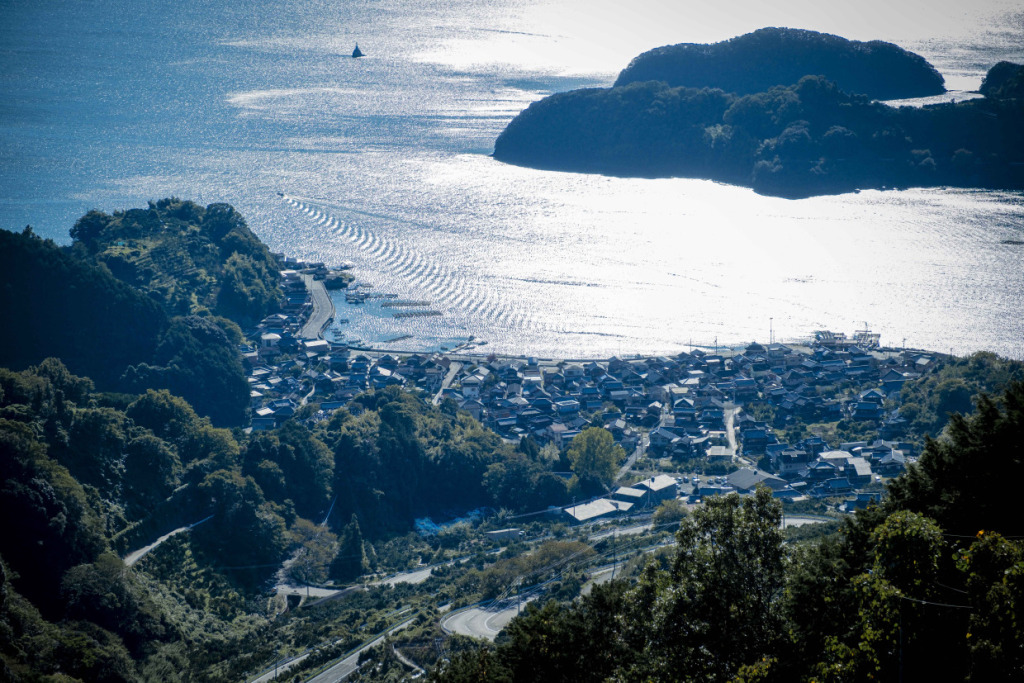
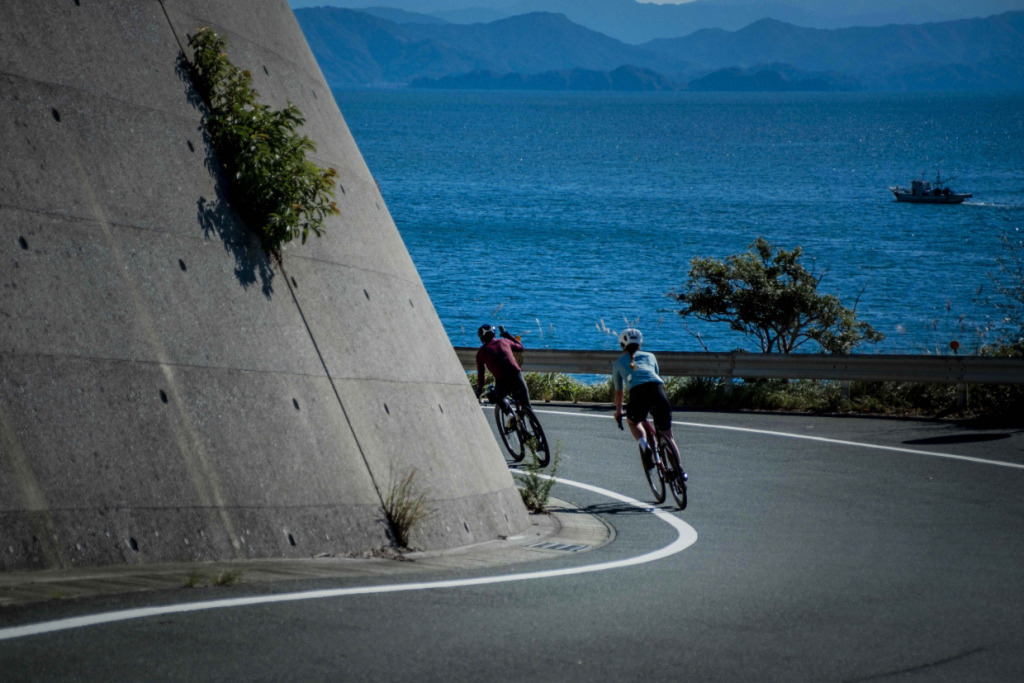
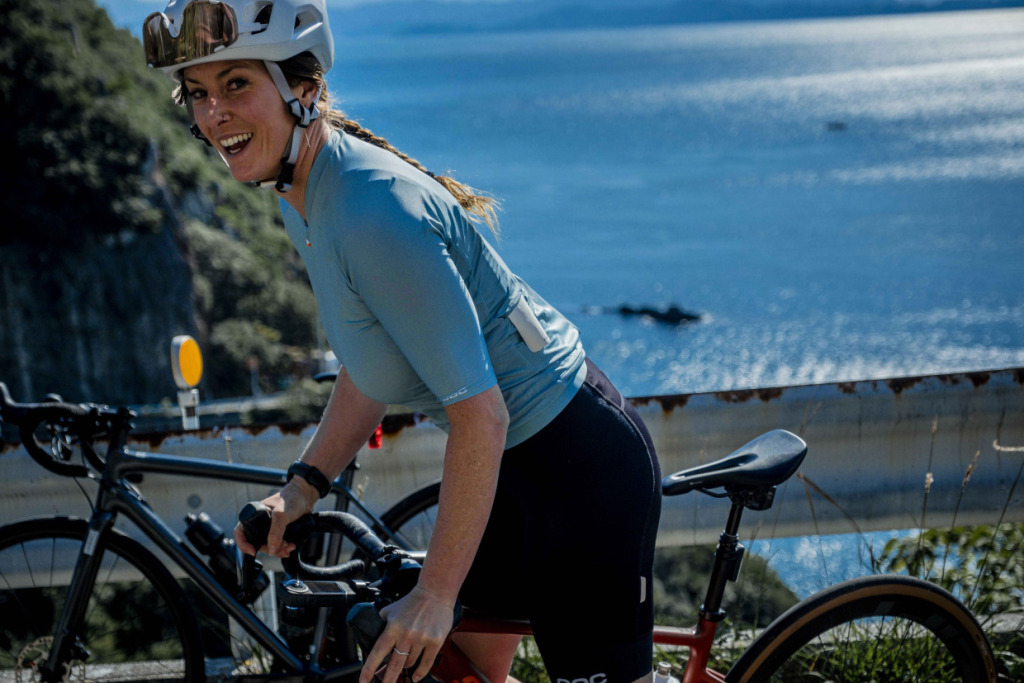
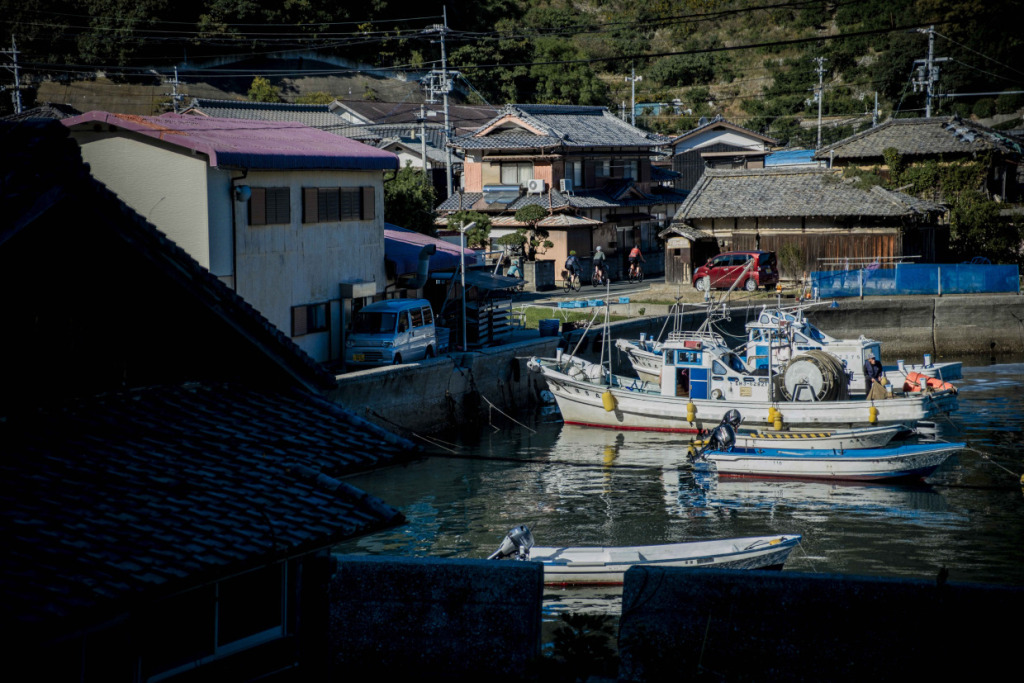
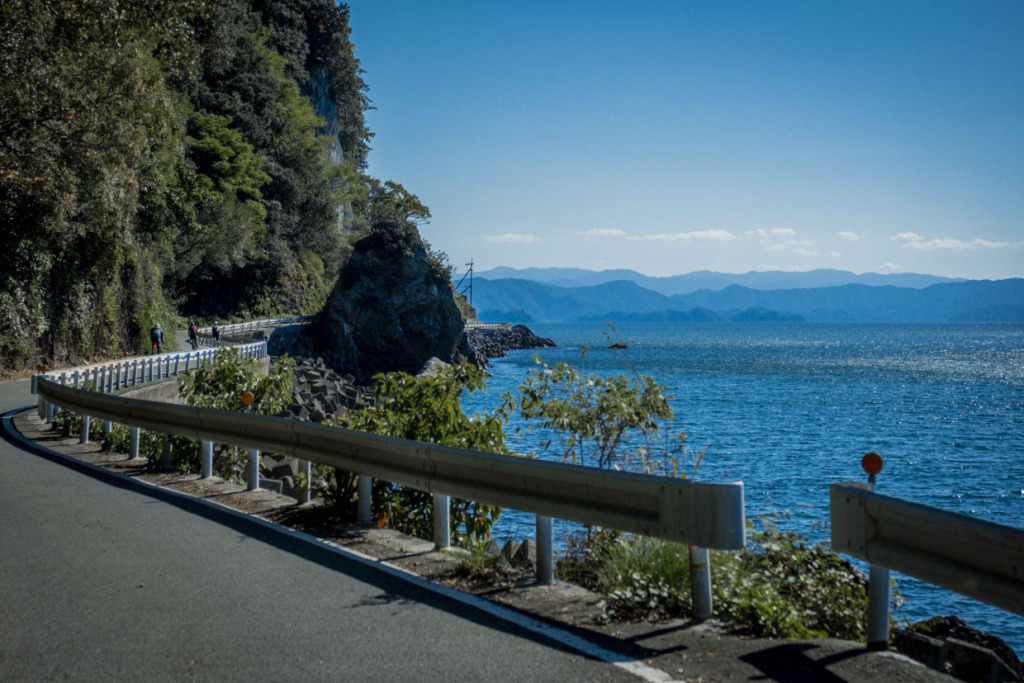
Our cycling train, which had been cruising at full speed until we reached the coastline, was soon shattered into pieces amidst the beauty of the capes, progress slowing to a crawl. With breathtaking views unfolding one after another, none of us could resist stopping our pedals. The only time we moved at a decent pace was when trees obscured the view—until the next panorama ensnared us once again, forcing us to pull out our smartphones from our jersey pockets.
Cries of “Wanderful!”, “AWSOME!”, and “Marvelous!” echoed across the capes from the English-speaking riders, while we countered with our own enthusiastic “すばらしい!”, “すげー!”, and “ヤベー!”. This mutual exchange of admiration made one thing abundantly clear—breathtaking scenery knows no borders.
After a long morning ride, our group, now visibly hungry, rolled into a restaurant at Akehamāre, a multi-purpose facility in the coastal village of Akebono. The wide stretch of white sand before us looked perfect for a summer swim—and sure enough, Lucky, our wild Aussie companion, had already taken the plunge. Throughout this trip, he’s been the guy who never hesitates to jump in, no matter the place. But come on, Lucky—it’s November, even if the water is warm!
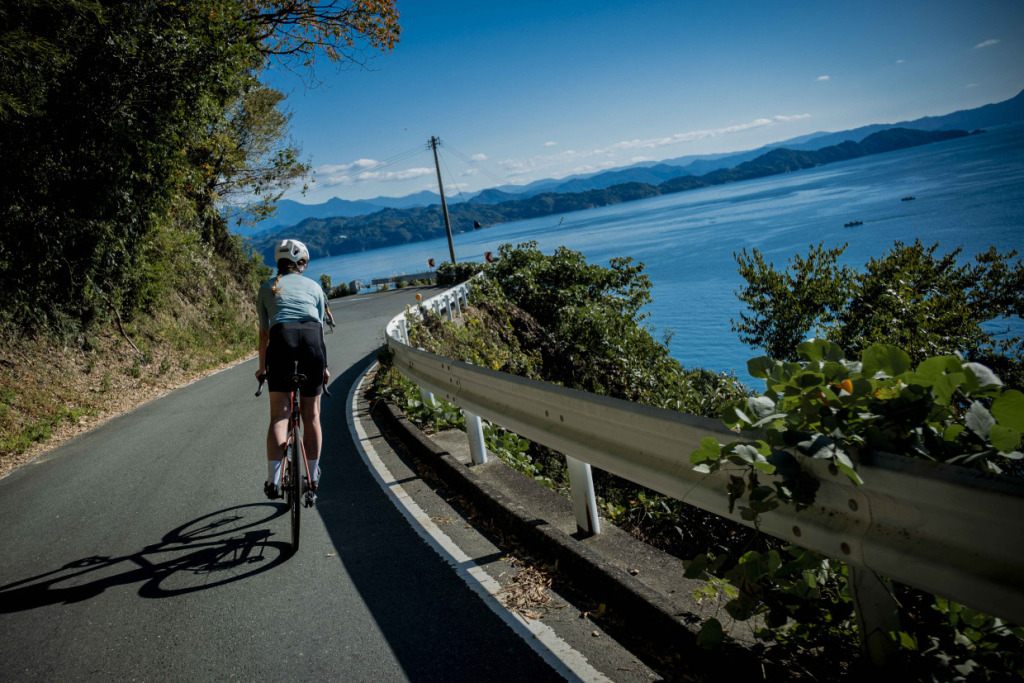
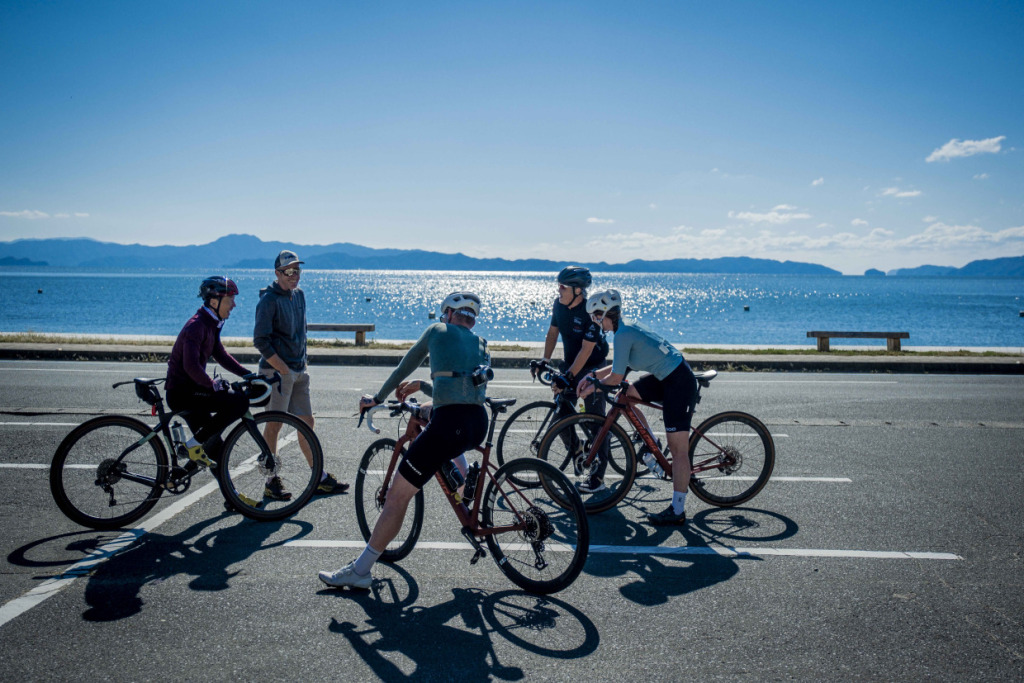
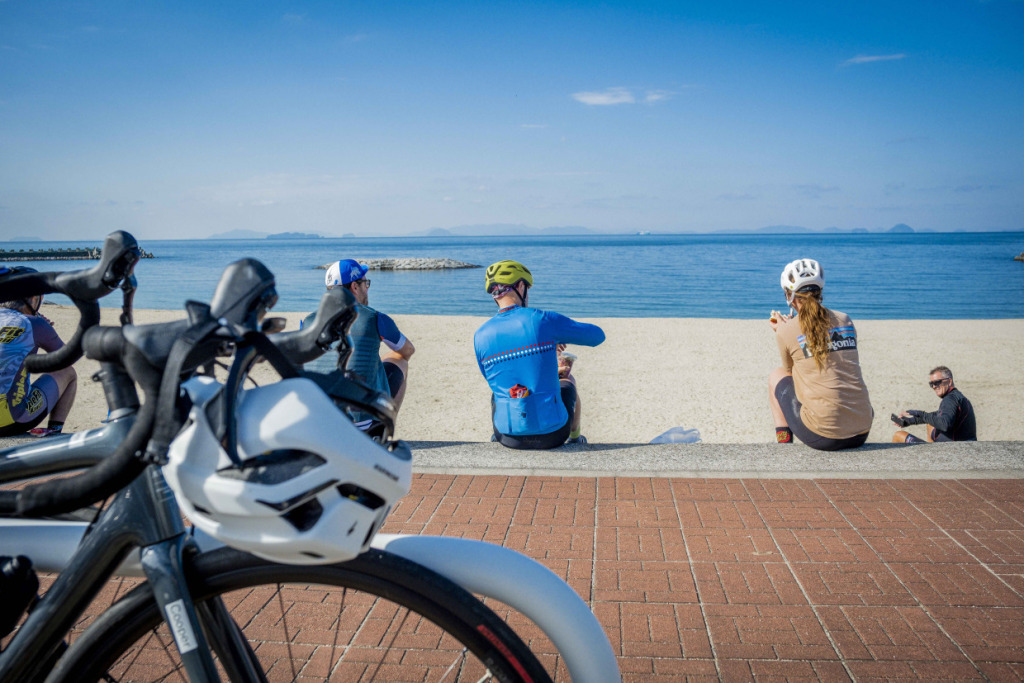
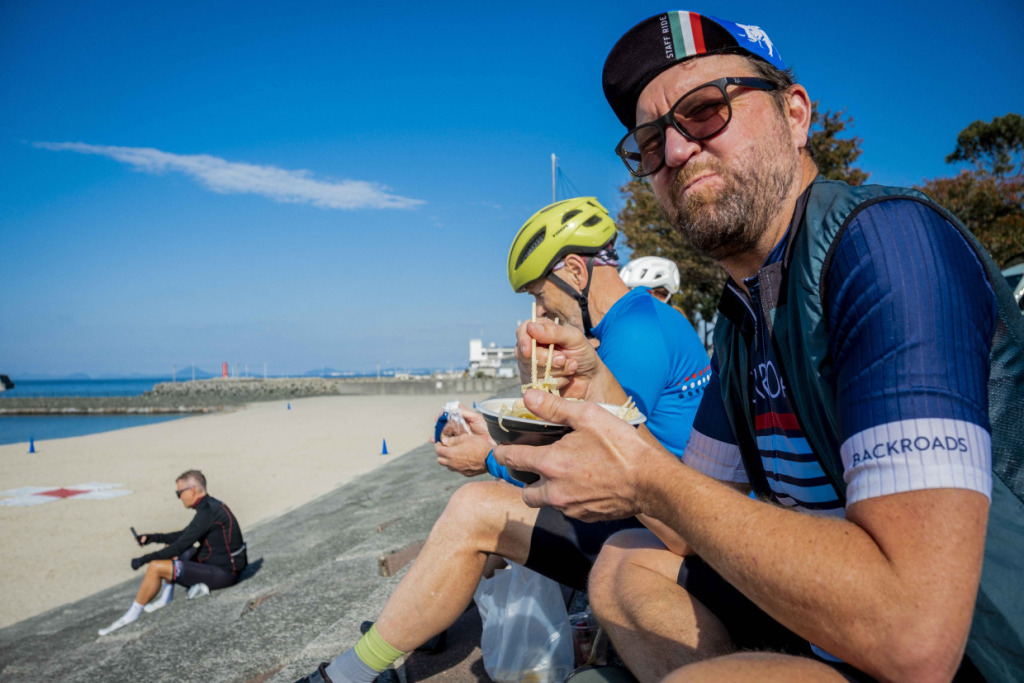
The starving cyclists, eager to indulge in the seafood of Nanyo, didn’t hesitate to choose the local specialty—tai-meshi set meal—despite being tempted by the wide array of menu options. Unlike the more common version of tai-meshi, which is cooked with rice, Uwajima-style tai-meshi is a fishermen’s dish where fresh slices of sea bream are soaked in a soy-based dashi broth, mixed with egg yolk, and poured over a bowl of steaming white rice. The combination of fresh sea bream, slightly sweet soy-infused broth, and rice was nothing short of perfect, and before we knew it, our bowls were empty.
With both body and soul fully recharged, we were ready for the final stretch to Uwajima. However, one last challenge stood in our way—a super-class mandarin orchard hill climb. From a small inlet village near sea level, a series of sharp switchbacks wound steeply up the mountainside, threading through a vast, fan-shaped expanse of citrus fields stretching toward the sky. The gradient was no joke. Our wild, fearless friend Lucky, never one to back down from a climb, launched a ferocious attack and quickly disappeared up the road. The rest of us took on the climb at our own pace, basking in the rare blessing of late autumn sunlight. The mandarins hung ripe and vibrant, and once again, the sea was breathtakingly beautiful—something that could never be said too many times.
Reaching the top of the mandarin fields came with a well-earned reward: a thrilling downhill ride. We whooped with childlike excitement as we soared down the descent, finally rolling safely into Uwajima. Our first stop was Warei Shrine, where we offered thanks for another safe day of cycling.
As the evening set in, our guides, Will and Tammy, led us to one of their favorite secret spots—a hidden corner of a small fishing port. There, we watched as the sun began its spectacular descent over Uwajima Bay. With beers in hand, we gazed at the mesmerizing scene of the sun melting into the sea and sky. It was the perfect way to savor the lingering emotions of a day spent under the brilliant Nanyo sun.
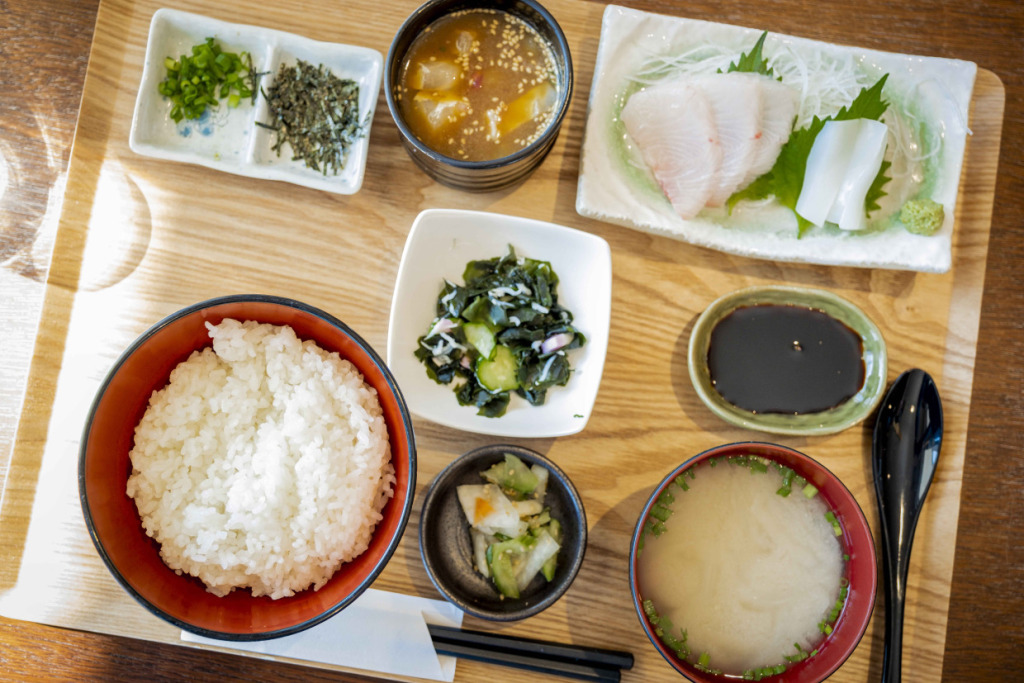
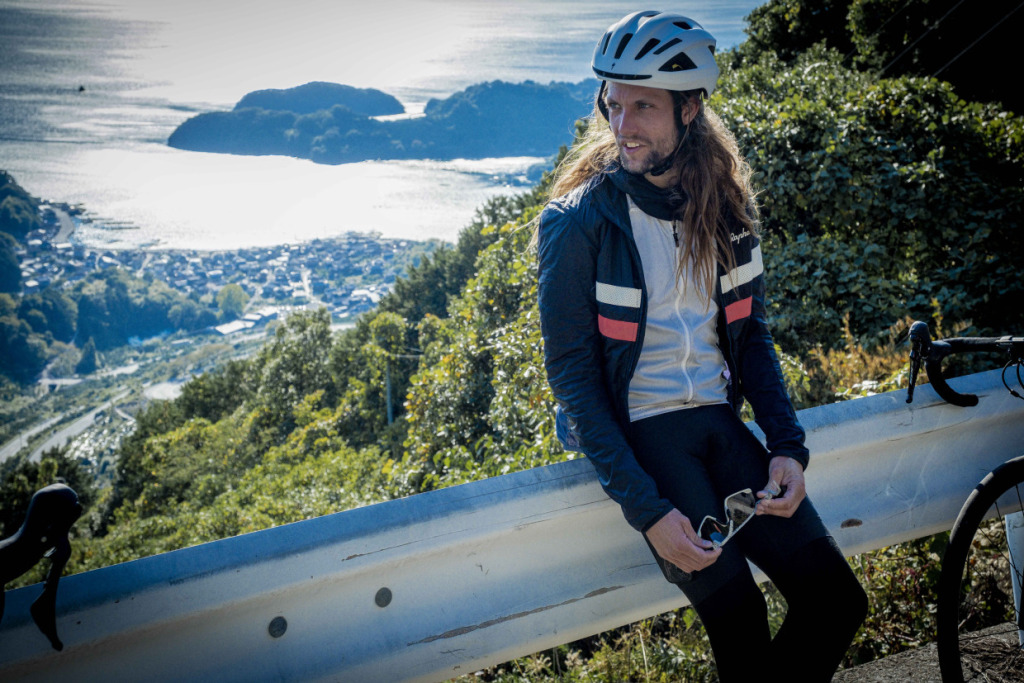

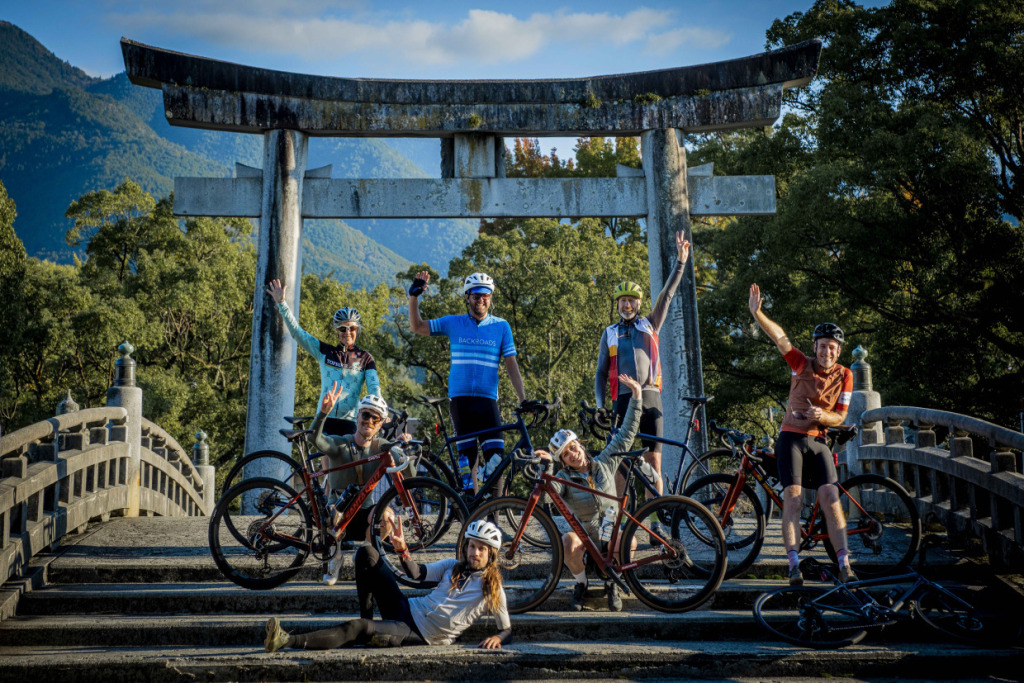
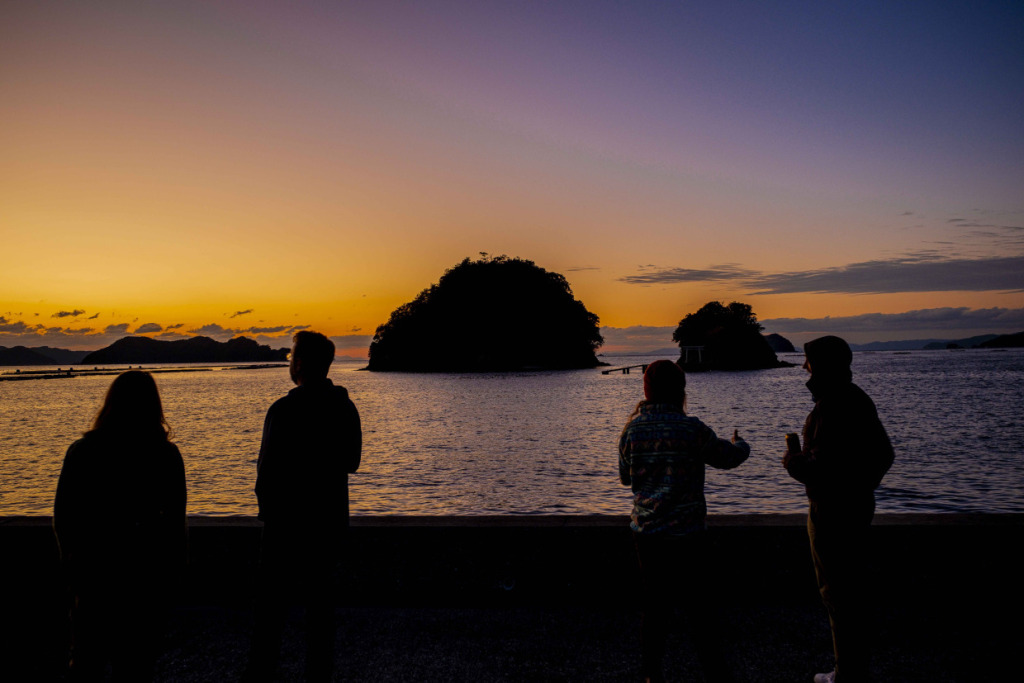
The last morning of our six-day journey began with a leisurely stroll through Uwajima. Our destination was Koya Ryokan, a historic inn that has been lovingly restored. Since its establishment in the Meiji era, Koya Ryokan has been cherished by countless cultural figures and politicians, including the famed writer Ryotaro Shiba. The wooden structure, deeply intertwined with Uwajima’s history, retains the essence of a traditional hatago (travel lodge) while having been reborn in recent years as a modern ryokan.
The sight of the imposing two-story building, standing strong for over a century, left us in awe. Inside, we immersed ourselves in the beauty of Japanese architecture—tatami rooms, shoji sliding doors, intricate ranma carvings, and calligraphy-adorned alcoves. While these details are second nature to us Japanese, they captivated our foreign companions, sparking an engaging cultural exchange.
Today was also the only day of the tour that included a train journey—an experience of cultural discovery in its own right. From Uwajima, we boarded the JR Yosan Line, a charming local railway, and headed north to Ozu. There, we would hop back onto our bikes for the final stretch toward our goal: Matsuyama.
The scenery beyond the train window unfolded at a gentle pace, offering a different perspective from the one we had enjoyed from our saddles. Some members of our group dozed off, lost in dreams. What kind of dreams would they have after such a rich and immersive week?
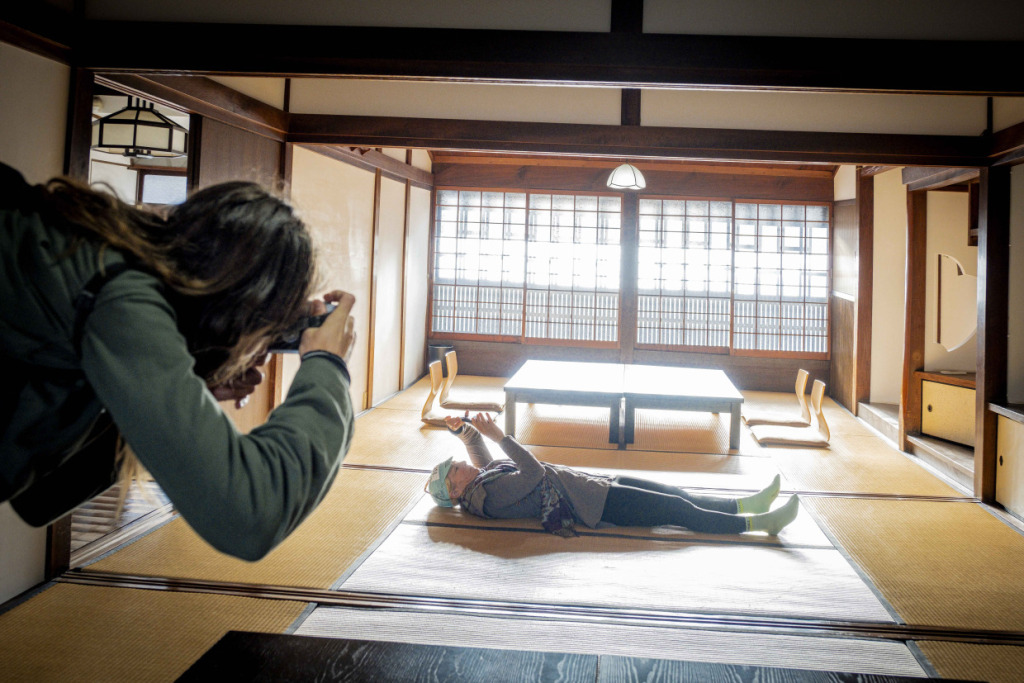
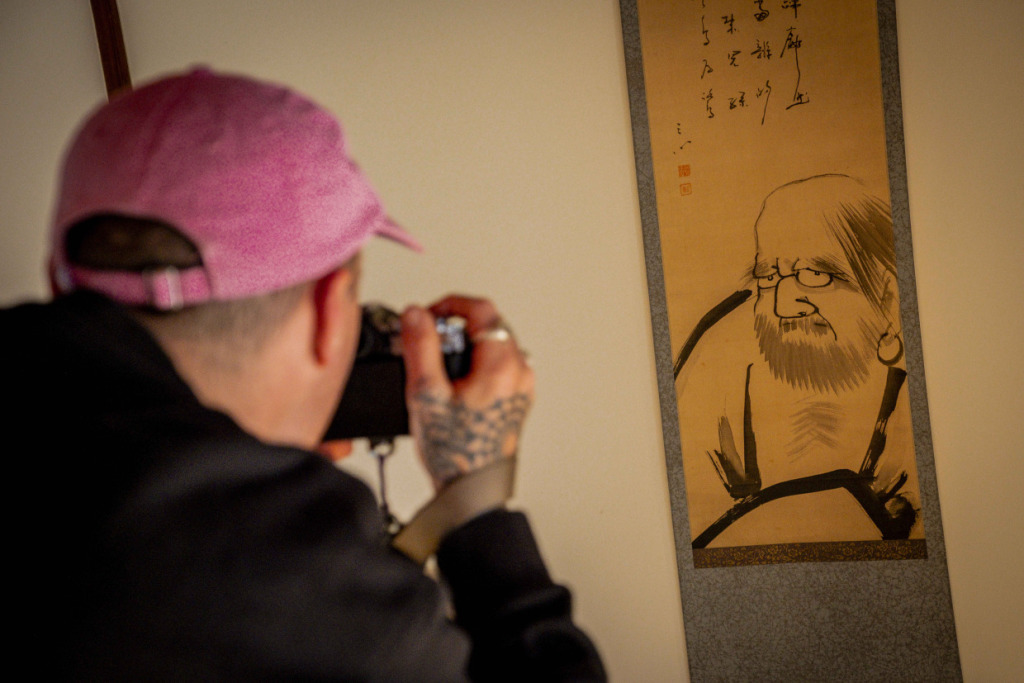
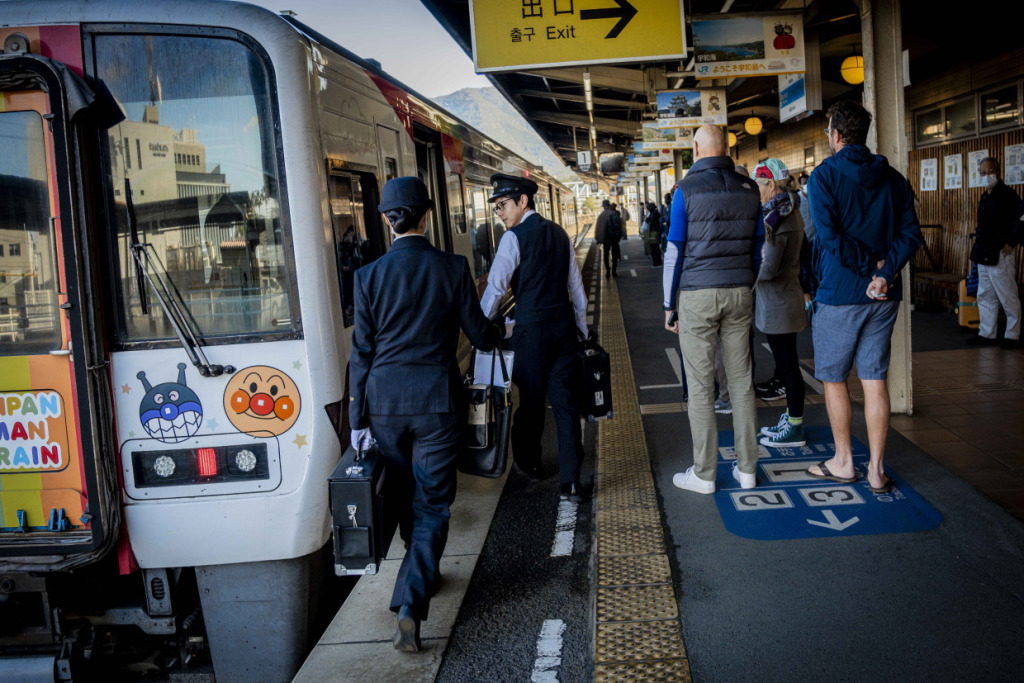
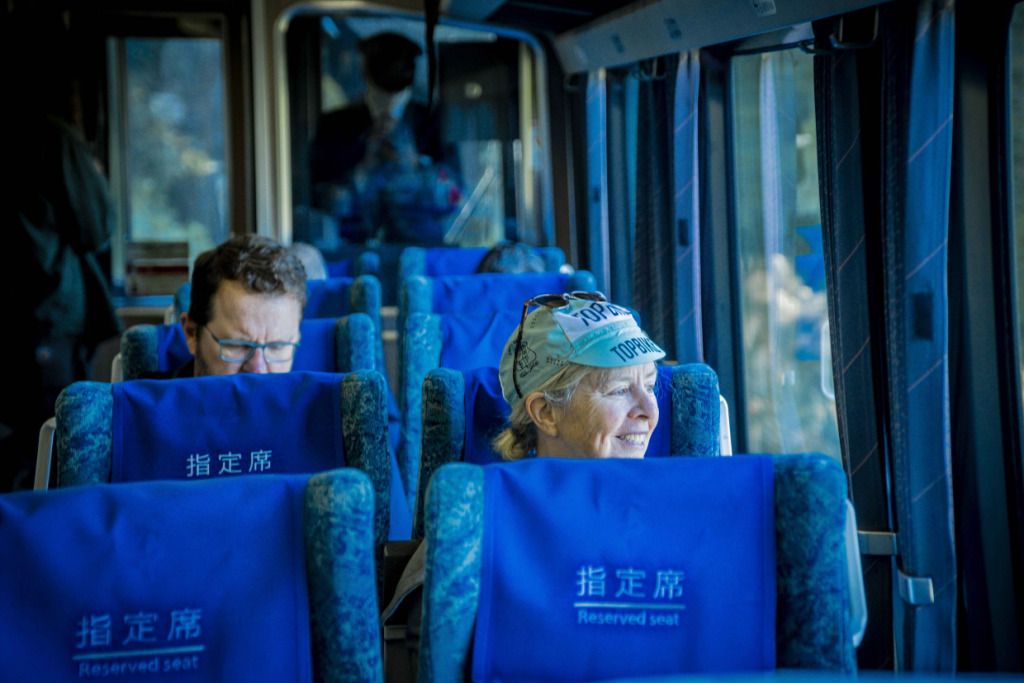
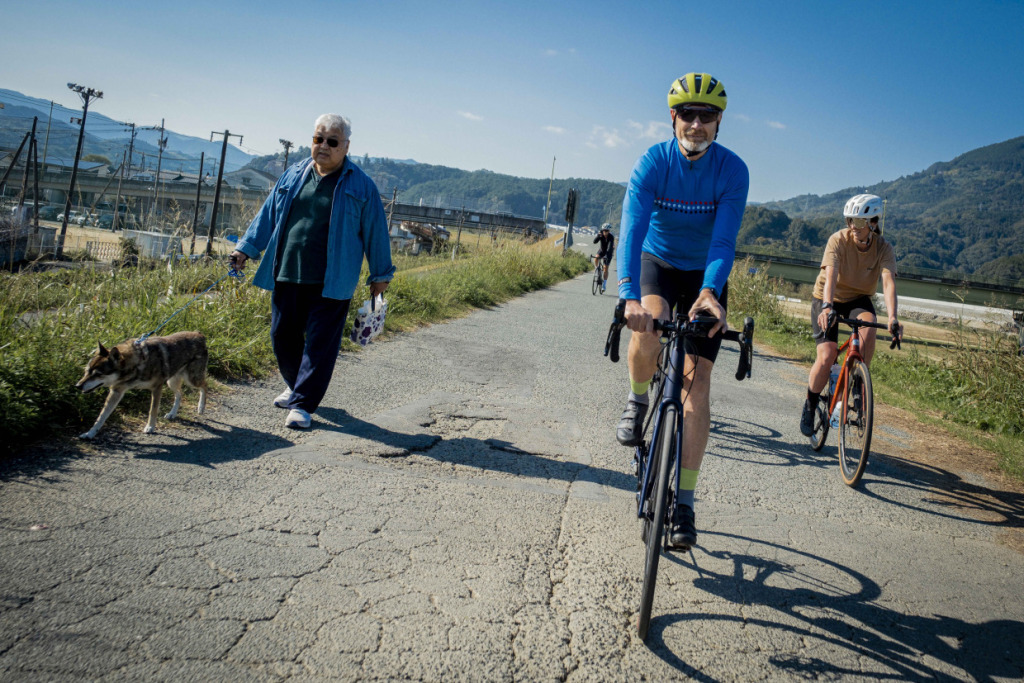
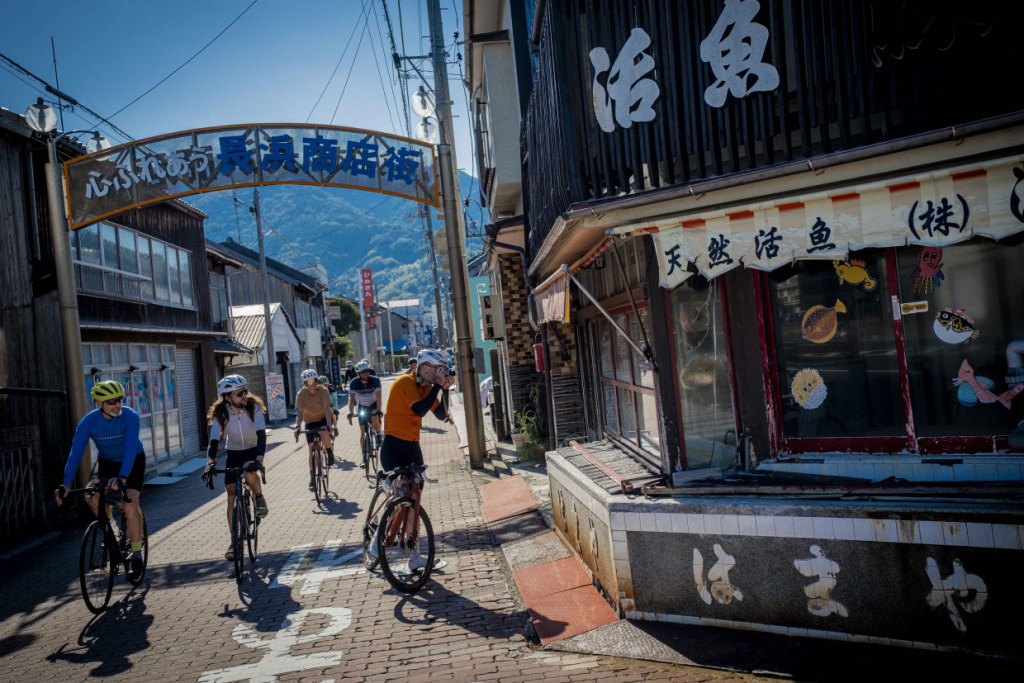
Back on our bikes, the remaining route to Matsuyama was mostly flat, with little elevation change. We went to north until Iyo-Nagahama by following the Hijikawa River, which gathers the waters of Nanyo, as it flowed from Ozu to the Seto Inland Sea. Riding alongside the river’s gentle current, we enjoyed a smooth, downhill-leaning cruise, arriving in Iyo-Nagahama in no time.
Crossing the town’s charming red drawbridge, we entered the historic port town connected to the legacy of Sakamoto Ryoma. As midday approached, we decided to take a different approach for lunch—each of us picking out our preferred meal from a convenience store for a seaside picnic.
“Japanese convenience stores are a wonderland!” Annie declared passionately, struggling to choose from the variety of onigiri fillings. It was amusing to see how our everyday norm could be an exciting discovery for someone else.
Biting into rice balls and karaage while gazing toward the coastline, we could already see Matsuyama in the distance—just a stone’s throw away. Riding along National Route 378, also known as the “Yuuyake-Koyake Line,” we found ourselves effortlessly gliding toward our final destination, thanks to its smooth, well-paved roads.
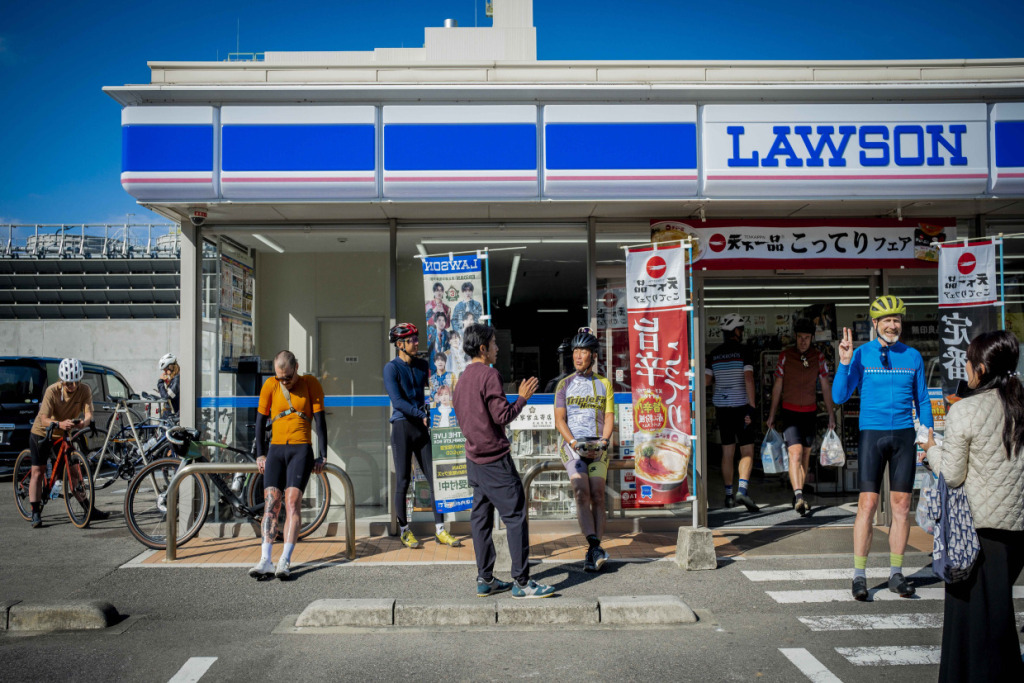
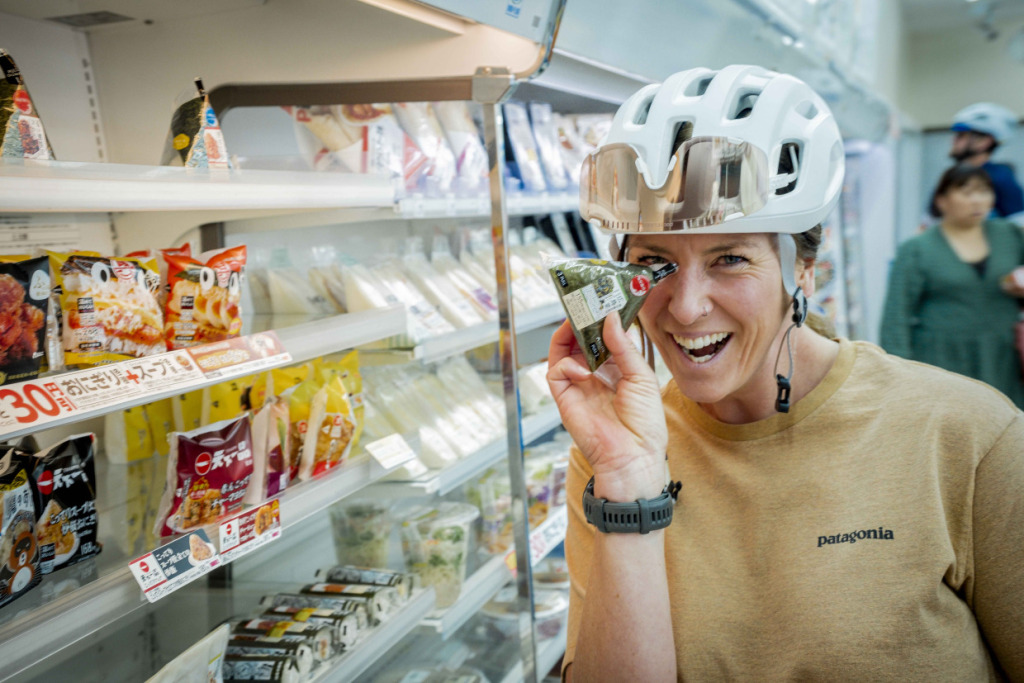
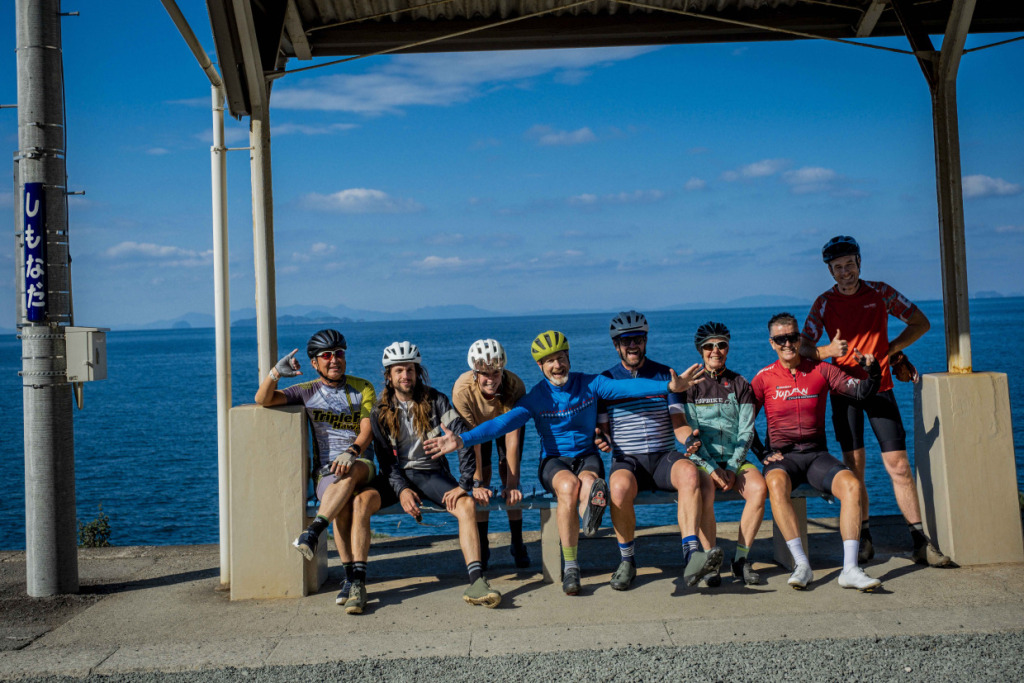
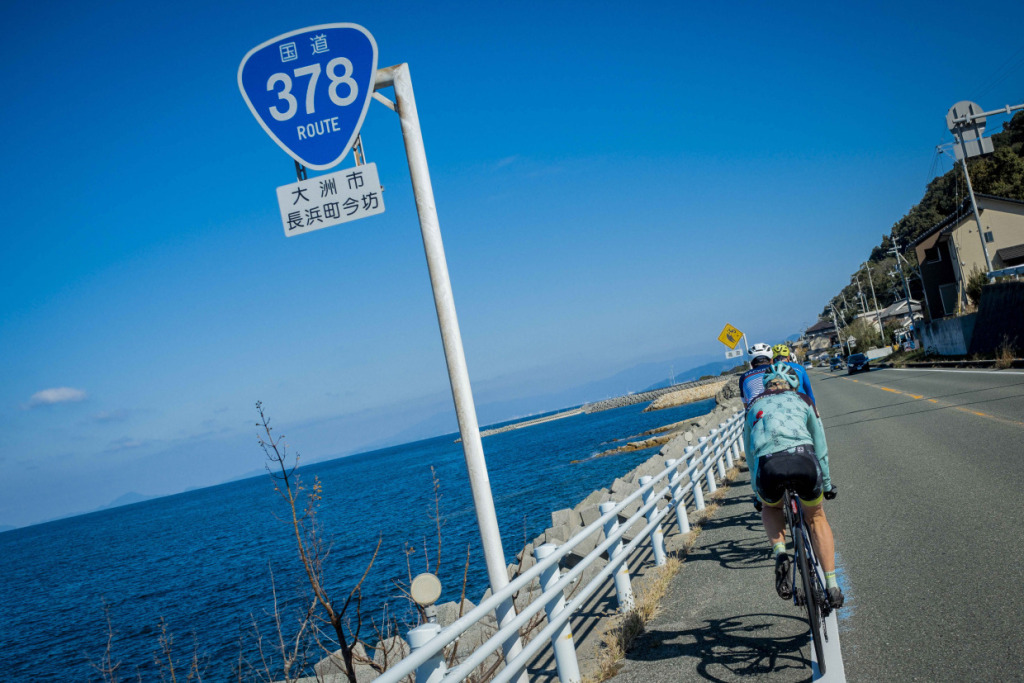
With only a short distance left to our final goal, Dogo Onsen, the late afternoon sun cast a warm glow over the road. Even on this last day, the journey had been rich and intense, packed with discoveries. As Matsuyama Castle’s keep came into view, we knew we had arrived. From the hillside above Ishite-ji, the 51st temple of the Shikoku Pilgrimage, Kobo Daishi seemed to be watching over us—witnessing the completion of our journey around Ehime, which had felt both long and fleeting.
Over the past week, we had ridden together across sea, mountains, countryside, and city, sharing the road with cycling companions from different corners of the world. It had been a journey of discovering an Ehime we never knew. At the same time, it had also made us acutely aware of how much more was out there—the roads we didn’t take, the mountain passes we didn’t climb, the capes we didn’t reach. Without a doubt, Ehime is a land that endlessly tempts cyclists, something our international friends wholeheartedly agreed on. Now that we’ve stepped through the gateway into its endless depth, there’s no turning back—we need to explore more. And so, soaking in the legendary waters of Dogo Onsen, we made a firm promise to return to Ehime.
The End.
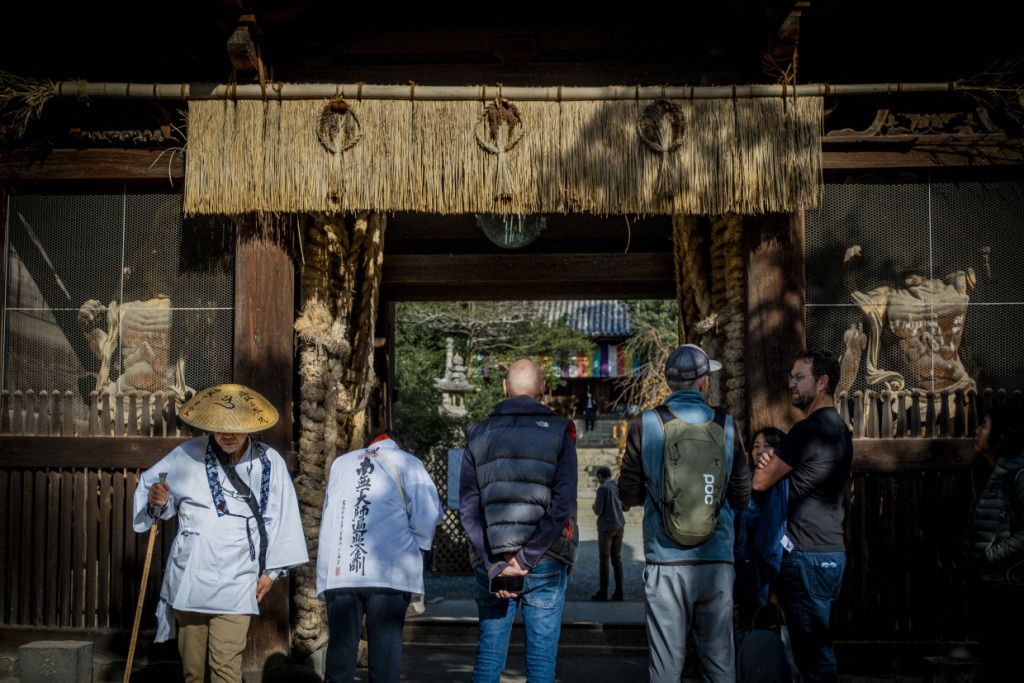
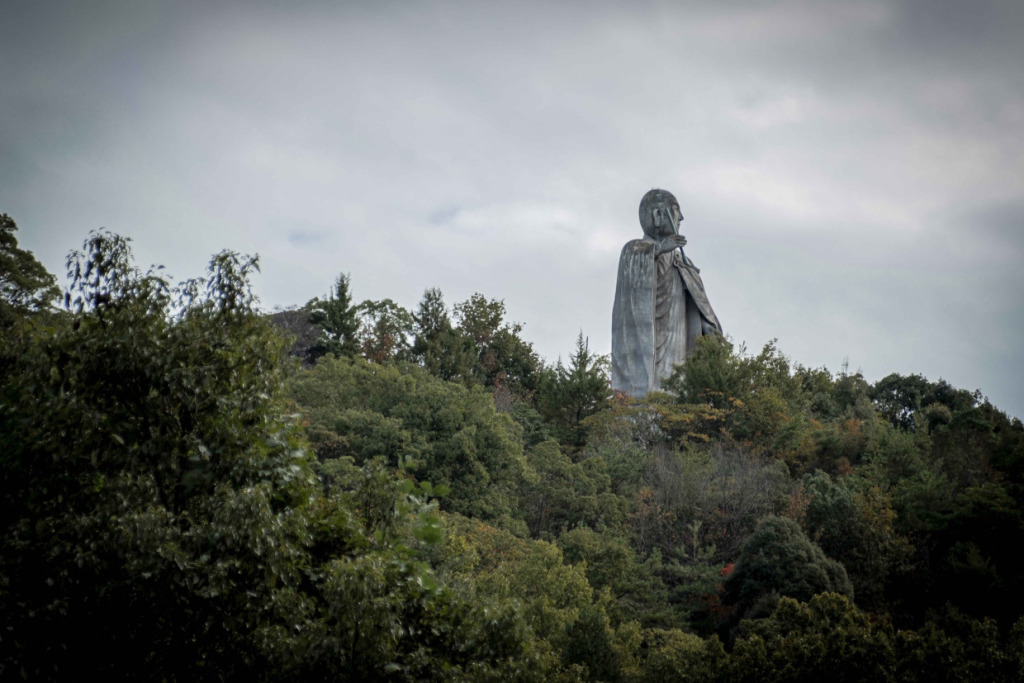
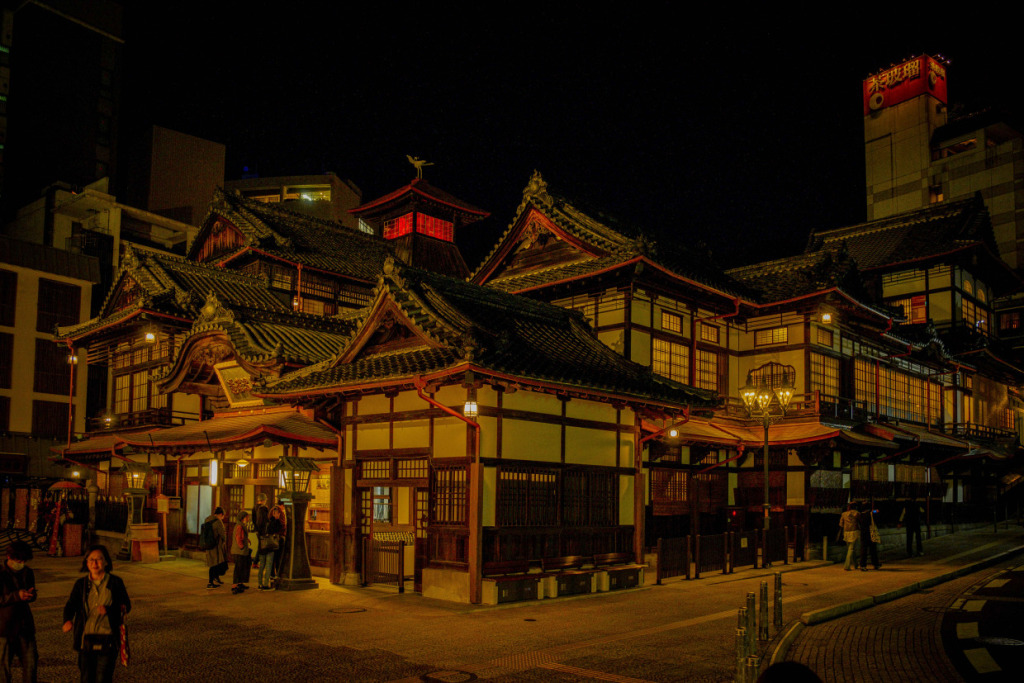
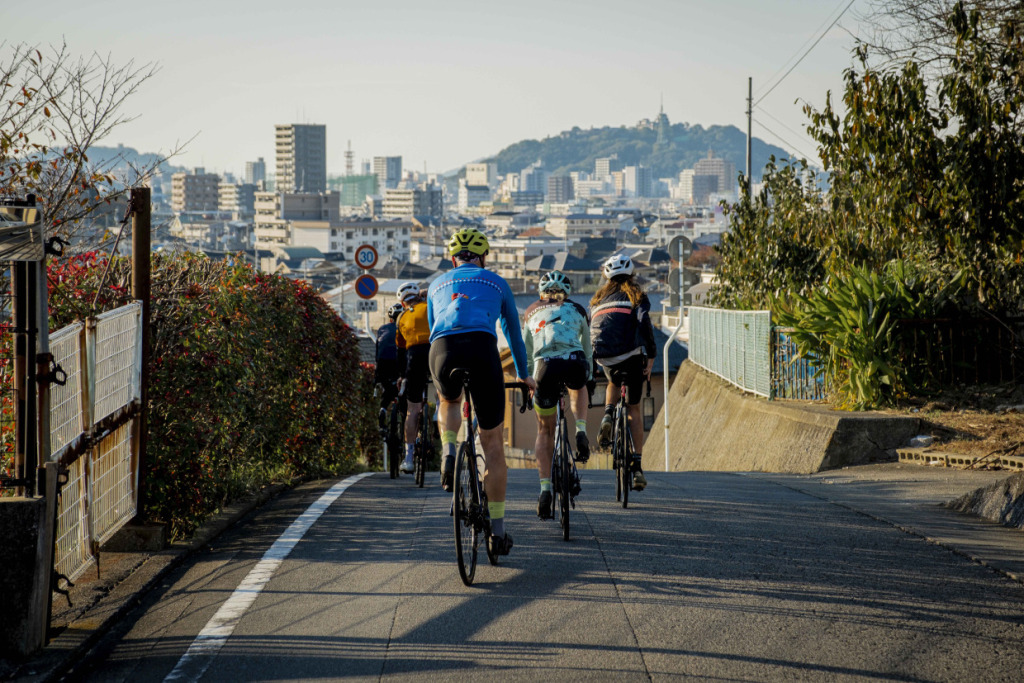
🚴♂️Ehime Prefecture Presents Cycling Monitor Tour Report for International Media
#01 Imabari City Area
#02 Saijo City ~ Mount Ishizuchi ~ Uchiko
#03 Uwajima City ~ Matsuyama City
Profile
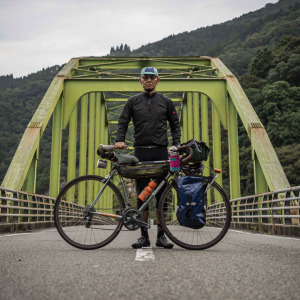
Eigo Shimojo
Born in Nagano Prefecture in 1974
Belongs to IPU Japan Photographers Union
He became independent in 2000 as a freelancer and established Greenhouse Studio, which handles a wide range of photography and video production.
His life’s work is pursuing underground HIPHOP and bicycle culture around the world.
Post Date:2025.03.19